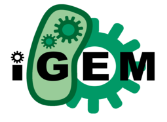Team:Alberta/FAQ
From 2013.igem.org
(Difference between revisions)
| Line 72: | Line 72: | ||
position:fixed; | position:fixed; | ||
margin-left:70px; | margin-left:70px; | ||
| - | margin-top:- | + | margin-top:-70px; |
width:180px; | width:180px; | ||
} | } | ||
| Line 78: | Line 78: | ||
position:fixed; | position:fixed; | ||
margin-left:650px; | margin-left:650px; | ||
| - | margin-top:- | + | margin-top:-100px; |
width: 150px; | width: 150px; | ||
} | } | ||
| Line 376: | Line 376: | ||
<body> | <body> | ||
<div class="titlebar"> | <div class="titlebar"> | ||
| - | <h3>The Littlest Mapmaker</h3> | + | <br> |
| - | <h4>"Exploration into the world of < | + | <h3><font color="#A80000"><font size="6">The Littlest Mapmaker</font></font></h3> |
| - | Team Alberta: University of Alberta</h4> | + | <h4><i><font size="2">"Exploration into the world of <font color="#A80000">DNA Computing</font>"<br/> |
| + | Team Alberta: University of Alberta</font></i></h4> | ||
<a href="http://www.ualberta.ca" class="ualberta-logo"><img src="/wiki/images/b/b3/Ualberta-logo.png" alt="University of Alberta"></img></a> | <a href="http://www.ualberta.ca" class="ualberta-logo"><img src="/wiki/images/b/b3/Ualberta-logo.png" alt="University of Alberta"></img></a> | ||
<a href="https://2013.igem.org" class="igem-logo"><img src="/wiki/images/a/ad/IGem-logo.png" alt="iGem Main Page"></img></a> | <a href="https://2013.igem.org" class="igem-logo"><img src="/wiki/images/a/ad/IGem-logo.png" alt="iGem Main Page"></img></a> | ||
Revision as of 20:25, 26 September 2013
FAQ
Doesn’t E. coli cause food poisoning? If E. coli is so dangerous, why are they being used in labs?
- Normal E. coli colonize the lower intestine of humans, while producing Vitamin K and protecting infection from other harmful bacteria.
- Only some strains of E. coli cause food poisoning, but our group is using a harmless, nonpathogenic strain. This train is engineered to contain mutations that would not allow the E. coli to survive outside the lab without particular nutrients.
- E. coli provides a well-studied and well-known model system to test and troubleshoot new trials on.
Reference: http://www.ncbi.nlm.nih.gov/pmc/articles/PMC1728375/
What if plasmids containing antibiotic resistance genes were released into the environment despite precautions?
- These genes are used in synthetic biology as selection tools.
- There are lower chances of gene uptake by wild bacteria compared to lab-strain bacteria which have perforated membranes.
- In the case that wild bacteria did uptake the antibiotic resistance gene, that gene would eventually be lost in the population without exposure to the antibiotic, because it is then a disadvantage for the bacteria to carry the unused plasmids. (Evidence observed in past with the decline of specific antibiotic resistance after the human population limited that antibiotic).
 "
"


